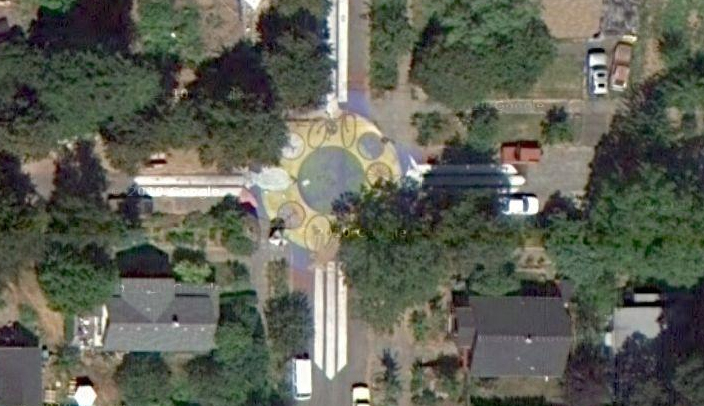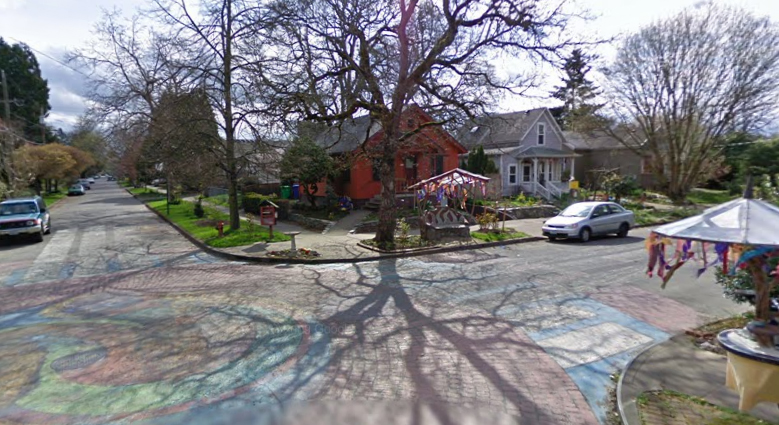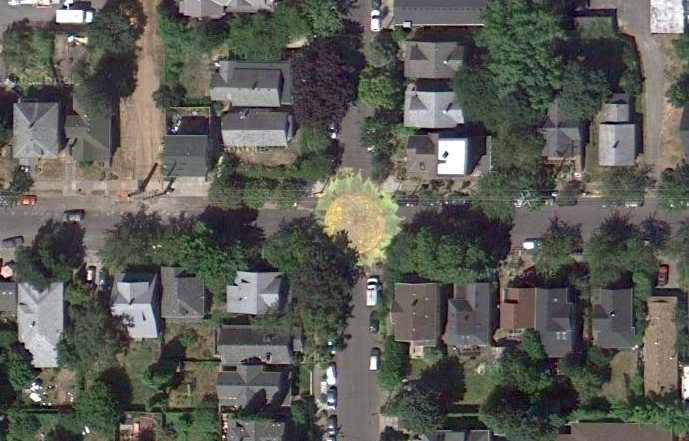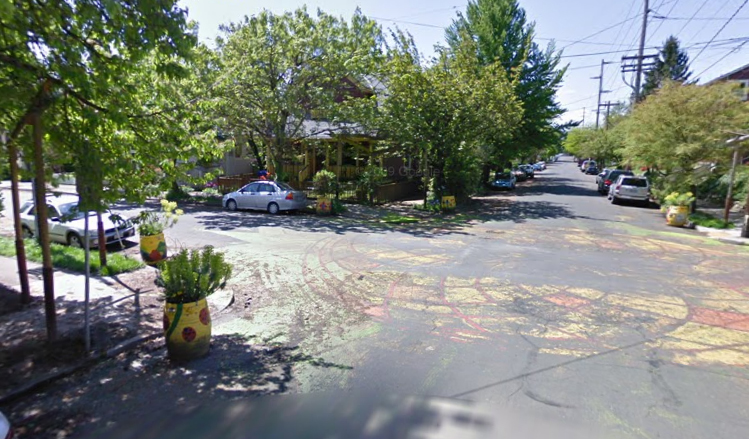Portland, OR
Share-it-Square
Background
Share-it-Square is at Sherret Street and 9th Avenue in the Sellwood Neighborhood of Portland, Oregon. It was first constructed in 1996 for $65. Changes and improvements are ongoing.
Share-It Square was the first community-initiated and community-built project in Portland. When a group of Sellwood neighbors began building an unauthorized gathering space, a Portland city official’s response was, “That”s public space. Nobody can use it.”
Local residents, including Mark Lakeman, who went on to start City Repair, a local nonprofit that helps citizens design and build social gathering spaces in their neighborhoods, were primarily responsible for the design and implementation of this project.
“Our cities and places are no longer ours. We’re not building our own places; we’re not designing them to fit our own needs. Our lives are zoned like we’re a resource to be managed. We're housed here, and then this is where we work in order to pay for the housing we barely get to live in. Mixed use here. Monocultural use here. Parking garage. Maybe a waterfront here. Park. Park. It doesn't add up. None of them are really whole.” – Mark Lakeman.
The neighbors chose to transform an intersection, because a crossroads is a gathering place where people come together. “In America, our great archetype is the main street, which is not really a center. It’s just a flow. It’s a movement corridor, and you have to yell across the street because there isn’t a place in the middle. There isn't a social commons that you can attain and occupy.”
During the first project, the neighbors who lived around the intersection came out on the weekend, painted a design in the street, built all the structures around the corners–a bench, a lending library, a 24-hour tea stand, a children’s playhouse, a kiosk for sharing neighborhood information–and turned the intersection into an interactive social space.
Since then people have built saunas, put in gardens and helped each other paint their houses. Americans move every four to seven years, and that period of time is visibly lengthening right around that intersection because people want to live there. Families are clustering around it, having kids or bringing their kids, increasing the number of children in the neighborhood. There is more shared childcare and more adults interacting with kids on the street.
“New projects emerged over the years, as the intersection got repainted for about $500, which was raised by residents. People worked together. One neighbor built an earthen oven in the shape of her Australian tree frog, Oblio. It gets fired up for neighborhood pizza parties. Several neighbors went door to door and took 60 to 70 orders for fruit trees, huckleberry bushes, and other edible plants that will make the neighborhood a “fruitopia,” perfect for “grazing” as people walk through it.” – Mark Lakeman
Creation of the Square led to city adoption of the ordinance that allowed similar projects to be created. Portland’s ordinance requires that 80 percent of neighbors within two blocks sign statements approving the plan. After installation of Share-It Square, organizers surveyed their neighbors and found that an overwhelming majority (over 85% in each case) felt that crime had decreased, traffic had slowed and communication between neighbors had improved.
Sunnyside Piazza
Background
The Sunnyside Piazza is located at SE 33rd and Yamhill Street in Portland, Oregon. It was first constructed in 2001, built by local residents and City Repair.
In 2001, neighbors were complaining of noise, speeding, drugs, and abandoned cars. After a series of meetings and workshops facilitated by City Repair, they determined to paint a sunflower in the middle of the intersection, turning it into a piazza. One neighbor provided 28 gallons of paint. The city's street sweepers cleaned the intersection. Planter barrels were placed on either side of the four corners to keep people from parking in the piazza and to slow traffic down. Neighbors had a community gathering, complete with dancing and a visit from the winged T-Horse.
The next year, the city approved plans for trellises on all four corners, the first arches built over sidewalks in Portland since the stone gateways to Laurelhurst Park some 100 years ago. One neighbor, who had initially opposed the painting of the intersection, came up with the idea to plant honeysuckle in the trellises. Neighbors raised the money and did the work.
There have been a few acts of vandalism, but nothing serious. “Some kids have ‘laid rubber’ in the middle of our intersection, there’s often litter and one time someone pulled out the wiring in our kiosk.”
Jan Semenza, whose studies of public health have suggested that “urban planning processes may contribute to the epidemics of obesity, diabetes and depression that are sweeping the United States,7rdquo; has assigned his students to study neighborhood reactions to the Sunnyside Piazza over time, and to compare crime and other statistics with those at comparable unimproved intersections in demographically parallel neighborhoods. After more than 700 interviews, they concluded that 65 percent of Sunnyside Piazza-area residents rated their neighborhood an excellent place to live, compared with 35 percent at another similar but unimproved intersection. Also, 86 percent of Sunnyside neighbors reported excellent or very good general health, compared with 70 in the adjacent neighborhood. And 57 percent versus 40 percent said they felt “hardly ever depressed,” even in Portland's rainy weather. Calls for police services have decreased since the intersection repair.
Additional City Repair Projects
In 2010, there were 200 major sites and almost 300 little projects that have been built in Portland and around the state.
“Some of them are really simple things. Like, there’s this wonderful intersection that has a painting of an oak tree, in honor of a tree that used to stand there. Everyone called it Ruth’s tree after their neighbor, who had planted it when she was a little girl. When she was in her 90s, she died. Shortly after, the tree fell over into the intersection. So the community comes out and paints this huge effigy of the tree, right there. Then there’s the T-Horse, which is a mobile tea house–it travels around to different neighborhoods in Portland, and wherever it goes people gather to drink tea, or play Frisbee, or whatever. It’s a vehicle with enormous wings, so it really entices people out.”
“The Memorial Lighthouse is also beautiful. It’s a solar-powered pillar of cob that glows at night, decorated with bicycle wheels and mosaic stained glass. It was built in memorial to a bicyclist who was killed there by a truck. His mother and friends would bring flowers and gifts, and leave them in the place where he died. His mother would come and mourn him, just sitting there on the sidewalk. Finally the neighbors asked if one of the corners of the intersection–a corner of a person’s yard–could be turned into a memorial to him and a place for his mother to sit. So this beautiful celebration of his life was created. He was a bicycle activist, so there’s a strong bike theme.” – Mark Lakeman
At Southeast Eighth and Ankeny Streets, a shrine to the Virgen de Guadelupe was conceived, designed, and built with the Mexican day-laborers who wait on the streets in that neighborhood to be picked out for work.
Lessons Learned
Potential Benefits:
- Creates a sense of place in the neighborhood.
- Reduces crime by focusing more attention on the street.
- Expresses the local culture.
- Provides social gathering space at low cost.
Potential Issues:
- City ordinances: City ordinances may require modification to allow projects of this type.
Sources
Lerch, Daniel. “Sunnyside Piazza” Project for Public Space (http://www.pps.org/great_public_spaces/one?public_place_id=504)
Brooke Jarvis, “Building the World We Want: Interview with Mark Lakeman” May 12, 2010 (http://www.yesmagazine.org/happiness/building-the-world-we-want-interview-with-mark-lakeman)
Stephen Silha “Street-corner Revolution” Jul 20, 2004 (http://www.yesmagazine.org/issues/what-is-the-good-life/998 “Turning Space Into Place: Portland’s City Repair Project” (http://www.manymouths.org/2009/08/turning-space-into-place-portlands-city-repair-project/)
Photo Sources
MIG, Inc.




